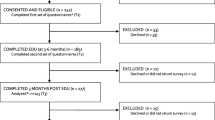Abstract
The incidence of skin, most HPV-related, liver, and lung cancers can be reduced through primary prevention. Morbidity from breast and testicular cancers can be reduced through secondary prevention. Thus, it is important to understand the mechanisms that predict engagement in primary and secondary prevention behaviors for these cancers. We investigated the roles of knowledge of cancer prevention, perceived importance of cancer prevention, and self-efficacy to engage in prevention steps in order to predict college students’ actual engagement in cancer prevention behaviors (CPB). Participants were 315 undergraduates who completed an online survey to assess these constructs. Hierarchical linear regression analyses were used to model knowledge, self-efficacy, and perceived importance as predictors of CPB for a range of cancers. Self-efficacy predicted CPB similarly across all cancers such that having a higher level of self-efficacy to prevent the cancer predicted having engaged in more CPB. Increase in knowledge predicted an increase in the frequency of CPB for skin and HPV-related cancers. Perceived importance of prevention predicted skin cancer CPB. These findings can be used to tailor cancer prevention programs for undergraduates to achieve greatest impact.

Similar content being viewed by others
References
American Cancer Society (2013) Cancer facts and figures 2013. American Cancer Society, Atlanta
Day A, Wilson C, Hutchinson A, Roberts RM (2013) The role of skin cancer knowledge in sun-related behaviours: a systematic review. J Health Psychol 19(9):1143–62, 0: 1–29
López RV, Tanjasiri SP, McMahan S (2008) College-aged men’s (18–24) knowledge and perceptions of human papillomavirus and cervical cancer. Calif J Health Promot 6:143–155
Prochaska JO, DiClemente C (1984) The transtheoretical approach: crossing the traditional boundaries of therapy. Dow Jones/Irwin, Homewood, IL
Ehret PJ, Ghaidarov TM, LaBrie JW (2013) Can you say no? Examining the relationship between drinking refusal self-efficacy and protective behavioral strategy use on alcohol outcomes. Addict Behav 38:1898–1904
Kratzke C, Vilchis H, Amatya A (2013) Breast cancer prevention knowledge, attitudes, and behaviors among college women and mother–daughter communication. J Community Health 38:560–568
McGilligan C, McClenahan C, Adamson G (2009) Attitudes and intentions to performing testicular self-examination: utilizing an extended theory of planned behavior. J Adolesc Health 44:404–406
Mee S (2014) Self-efficacy: a mediator of smoking behavior and depression among college students. Pediatr Nurs 40(9–15):37
Rovito MJ, Gordon TF, Bass SB, DuCette J (2011) Perceptions of testicular cancer and testicular self-examination among college men: a report on intention, vulnerability, and promotional material preferences. Am J Men Health 5:500–507
Gerend MA, Barley J (2009) Human papillomavirus vaccine acceptability among young adult men. Sex Transm Dis 36:58–62
Godar DE, Urbach F, Gasparro FP, van der Leun JC (2003) UV doses of young adults. Photochem Photobiol 77:453–457
American College Health Association. 2013. American College Health Association National College Health Assessment II- reference group executive summary. Hanover, MD
Mitka M (2009) College binge drinking still on the rise. JAMA 302:836–837
Agaku IT, King BA, Dube SR, Centers for Disease Control and Prevention (2014) Current cigarette smoking among adults—United States, 2005–2012. Morb Mortal Wkly Rep 63:29–34
American Cancer Society. 2010. What are the key statistics about testicular cancer? American Cancer Society. http://www.cancer.org/cancer/testicularcancer/detailedguide/testicular-cancer-key-statistics. Accessed 1 Aug 2012
Centers for Disease Control and Prevention. 2011. Breast cancer: what screening tests are there? http://www.cdc.gov/cancer/breast/basic_info/screening.htm. Accessed 1 Aug 2012
U.S. Preventive Services Task Force (2009) Screening for breast cancer: U.S. Preventive Services Task Force recommendation statement. Ann Intern Med 151:716–726
Licht AS, Murphy JM, Hyland AJ, Fix BV, Hawk LW, Mahoney MC (2010) Is use of the human papillomavirus vaccine among female college students related to human papillomavirus knowledge and risk perception? Sex Transm Infect 86:74–78
Centers for Disease Control and Prevention. 2011. Skin cancer: sun safety. http://www.cdc.gov/cancer/skin/basic_info/sun-safety.htm. Accessed 1 Aug 2012
Centers for Disease Control and Prevention. 2012. Lung cancer: what are the risk factors? http://www.cdc.gov/cancer/lung/basic_info/risk_factors.htm. Accessed 1 Aug 2012
National Cancer Institute. 2012. HPV and cancer. http://www.cancer.gov/cancertopics/factsheet/Risk/HPV. Accessed 1 Aug 2012
Cantor D, Covell J, Davis T, Park I, Rizzo L (2005) Health Information National Trends Survey 2005 (HINTS 2005): final report. National Cancer Institute, Bethesda, MD
Casciotti DM (2010) Controversy and cancer prevention: media messages about the HPV vaccine. Johns Hopkins University, Baltimore, MD
Jonnalagadda S, Bergamo C, Lin JJ, Lurslurchachai L, Diefenbach M, Smith C et al (2012) Beliefs and attitudes about lung cancer screening among smokers. Lung Cancer 77:526–531
Seo D-C, Macy JT, Torabi MR, Middlestadt SE (2011) The effect of a smoke-free campus policy on college students’ smoking behaviors and attitudes. Prev Med 53:347–352
Acknowledgments
This work was supported by the University of Florida’s University Scholars Program. Thank you to Adithi Vemuri for her assistance with this project and to Dr. Lawrence Winner for his manuscript review.
Author information
Authors and Affiliations
Corresponding author
Additional information
This research was conducted at the University of Florida.
Rights and permissions
About this article
Cite this article
Werk, R.S., Hill, J.C. & Graber, J.A. Impact of Knowledge, Self-Efficacy, and Perceived Importance on Steps Taken Toward Cancer Prevention Among College Men and Women. J Canc Educ 32, 148–154 (2017). https://doi.org/10.1007/s13187-016-0996-3
Published:
Issue Date:
DOI: https://doi.org/10.1007/s13187-016-0996-3



